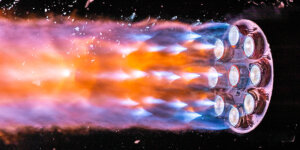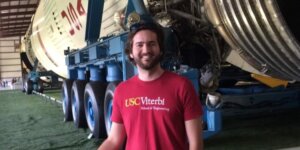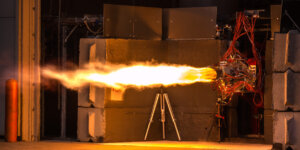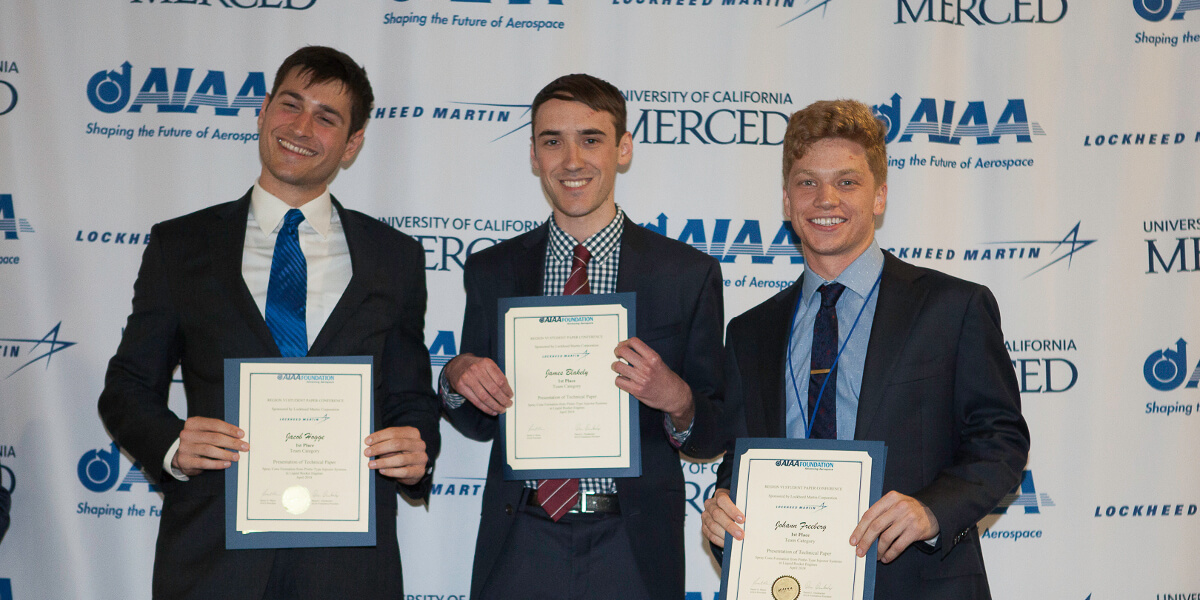
Jacob Hogge, James Blakely and Johann Freeberg pose with their awards at the regional AIAA Student Conference. Photo/AIAA
At the regional American Institute of Aeronautics and Astronautics (AIAA) Student Conference, held this year at the University of California, Merced on April 6-8, three senior mechanical engineering students won first place for their paper “Spray Cone Formation from Pintle-Type Injector Systems in Liquid Rocket Engines.”
Taking inspiration from their work with the USC Rocket Propulsion Lab (RPL) and the USC Liquid Propulsion Lab (LPL), for their senior design project, James Blakely, Johann Freeberg and Jacob Hogge set out to characterize the behavior of a rocket engine injector under different flow conditions and geometries.

Pintle injector tips. Photo/Johann Freeberg
“Our project sought to improve the existing public information available on pintle-injectors for rocket engines,” said Hogge, who is a core member of RPL and former lead injector designer of LPL.
In rocket engines that use liquid propellants, a rocket injector system is used to mix fuel with the oxidizer to create the combustion which propels the rocket. The system’s design is critical to the engine but is costly and associated with many challenges.
“All the data around this component is proprietary. Every time a new company sprouts up they have to do all of their own testing and whatnot. We wanted to create a database for companies in aerospace and student groups who are designing this so that we can better inform the public on how these are supposed to be designed,” Freeberg explained.
The team decided to focus on pintle-type injectors, which are ideal for mid-sized rocket engines. Pintle injectors comprise of an inner and outer tube in which the fuel and oxidizer flow. The fluid in the outer tube comes out in a cylindrical stream around the inner tube, while the fluid in the inner tube sprays outward through a series of holes. When the two fluids meet, a cone is formed.
The team found that the momentum of the fluids, which can be calculated from the geometry of the injector and velocity of the flow, determines the spray cone angle.
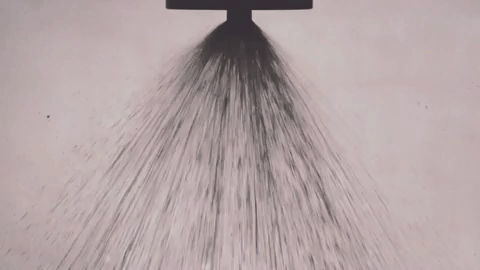
Liquid exiting the pintle injector tip and forming a spray cone. Video/Jacob Hogge
“The angle affects heat transfer in the rocket engine’s combustion chamber,” said Blakely, who is the lead recovery engineer for RPL. “If the angle is too wide, you could have propellant colliding with the combustion chamber wall which may or may not be desirable. Overall, having a relatively simple way to predict it helps establish expectations.”
This is the third year in a row in which students from the aerospace and mechanical engineering course “AME 441: Senior Projects Laboratory” have won first place at the regional AIAA student conference in the undergraduate category. In addition to a cash prize, winning teams are invited to compete in the international student competition during the SciTech Forum in San Diego, Calif. in January 2019.
“AME 441 is all about giving students the opportunity to work on something they are passionate about and it’s a great opportunity for them to show a potential employer, ‘I’m excited about this and here’s proof!’ In fact, Johann just received a position at Relativity Space partly due to his excellent manufacturing work on this project,” said the course’s lecturer, Matthew Gilpin.
All three students plan on joining the NewSpace industry after graduation, a term that encompasses the emerging private spaceflight industry. Freeberg and Blakely will continue their work in propulsion engineering at Relativity Space and SpaceX, respectively.
Published on April 27th, 2018
Last updated on November 29th, 2018




